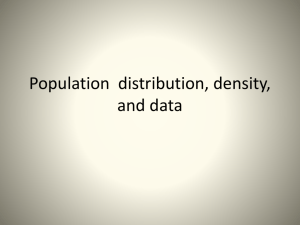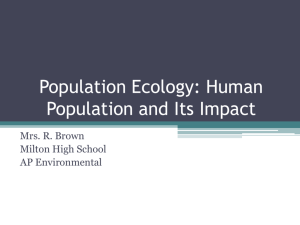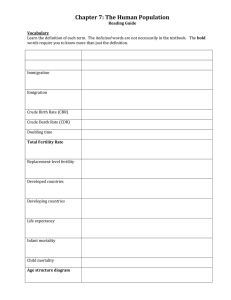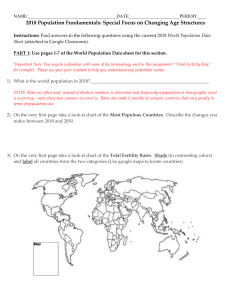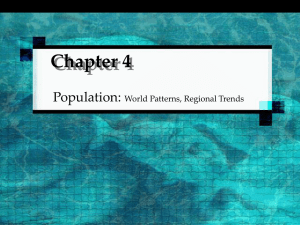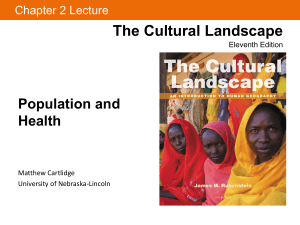The Human Population
advertisement
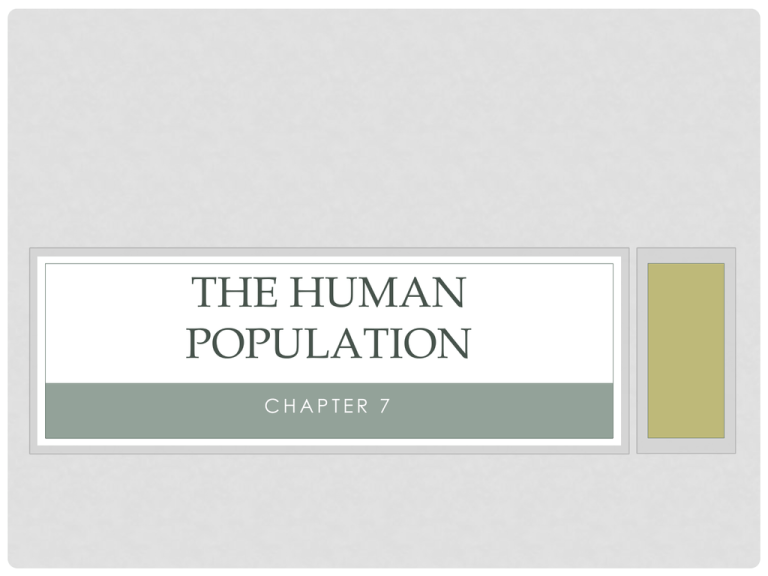
THE HUMAN POPULATION CHAPTER 7 EARTH’S CARRYING CAPACITY • Every 5 days the global human population increases by roughly 1 million lives: • 1.8 million infants born - 800,000 people die • What factors influence Earth’s carrying capacity for humans? • Food, water, timber, fuel, disease • Advances in technology • Will humans exceed Earth’s carrying capacity? • How do we know if we have? • What should we do about it? • What are the moral, religious, and personal freedom implications? WHERE ARE WE HEADED? U.N. world population projection: based on women having an average of 2.5 (high), 2.0 (medium), or 1.5 (low) children FACTORS THAT DRIVE HUMAN POPULATION GROWTH • Demography – the study of human population trends (demographer – scientists in this field) • Crude birth rate = number per 1,000 per year • Crude death rate = number per 1,000 per year • I = immigration (movement in) • E = emigration (movement out) • Global pop growth rate = CBR – CDR 10 • Nation pop growth rate = [CBR + I] – [CDR + E] 10 SOME COMPARISONS Average crude death (blue) and birth (yellow) rates for various groupings of countries in 2006 DOUBLING TIME • The number of years it takes for a population to double • Assumes that the growth rate is constant • Formula called the rule of 70 • Doubling time (in years) = 70 growth rate • Example: Population growth rate of 2% will double in 35 years: 70/2 = 35 FERTILITY • Total fertility rate • Estimate of the average number of children for each woman during her childbearing years • Not measured per 1,000 – is a measure per woman • In 2008 in the, U.S. TFR = 2.1 • Replacement-level fertility • The TFR needed to offset the average number of deaths in a population so that the current population size remains stable • This number is typically just over 2 • This also depends on rates of pre-reproductive mortality – death before a person has children – this depends on a country’s economic status UNITED STATES BIRTH RATES IN THE U.S. 1910 - 2006 FACTORS AFFECTING BIRTH RATES • • • • • • • • The cost of raising and educating children Availability of pensions Urbanization Education and employment opportunities Infant deaths Marriage age Availability of contraception and abortion Religious beliefs, traditions, and cultural norms FACTORS AFFECTING DEATH RATES • Death rates have declined due to: • • • • Increased food supplies and better nutrition Advances in medicine Improved sanitation and personal hygiene Safer water supplies • U.S. infant mortality is higher than it could be (ranked 46th world-wide) due to: • Inadequate pre- and post-natal care for poor • Drug addiction • High teenage birth rate DEVELOPED VS. DEVELOPING COUNTRIES • Developed countries – those with relatively high levels of industrialization and income • Example: U.S. • • • • Typically have replacement-level fertility of 2.1 TFR = 2.1 population is stable TFR < 2.1 population likely to decrease TFR > 2.1 population likely to increase • Developing countries – those with relatively low levels of industrialization and incomes of < $3 per person per day • Example: India, China DEVELOPING COUNTRIES • China is the largest country – has taken drastic population control measures • By 2050 India is predicted to pass China. Pakistan is projected to become 3rd, with Iran and Ethiopia following • Russia is losing 600,000 people/year after being the 4th largest country in 1950 – due to environmental pollution, hyperinflation, crime, corruption, disease, despair EFFORTS TO SLOW POPULATION GROWTH Governments may try these tactics: 1. Raising taxes 2. Charging other fees 3. Eliminating income tax deductions for a couple’s third child 4. Loss of health-care benefits, food allotments, job options • In China, couples who pledge to have no more than one child receive: 1. Extra food 2. Larger pensions 3. Better housing 4. Free medical care 5. Salary bonuses 6. Free school tuition for their one child 7. Preferential treatment in employment when their child enters the job market CHINA • Currently TFR = 1.6 • Has moved 300 million people out of poverty • Problems: • Strong male preference has lead to gender imbalance • Average population age is increasing • Not enough resources to support current population INDIA • Family planning program has basically failed due to: • • • • • • Poor planning Bureaucratic inefficiency Low status of women Extreme poverty Lack of administrative financial support Disagreement over the best ways to slow population growth THE BEST WAY TO SLOW POPULATION GROWTH • A combination approach works best: 1. Investing in family planning 2. Reducing poverty 3. Elevating the status of women – especially educational opportunities LIFE EXPECTANCY • The average number of years an infant born in a particular year in a particular country can be expected to live – influenced by availability of health care, access to good nutrition, exposure to pollutants • Usually expressed in 3 ways: • Overall (2008 - U.S. 78) • Men (2008 – U.S. 75) • Women (2008 – U.S. 81) • Men usually have higher death rates: • Biological factors, greater workplace dangers, more hazardous lifestyle choices, more likely to die in wars INFANT AND CHILD MORTALITY • Infant – deaths under age 1 per 1,000 live births • Child – deaths under age 5 per 1,000 live births • Sometimes the overall rates for a country vary widely from those for a segment of the population: • Infant mortality in U.S. = 6.6 • U.S. African Americans = 13.6 • U.S. Native Americans = 8.1 • Related to socioeconomic status and varying access to adequate nutrition and health care • An issue of environmental justice (Ch. 20) AGING AND DISEASE • Disease is an important regulator of human population • Infectious disease are the 2nd biggest killer worldwide after heart disease • Tuberculosis and malaria have been biggest portion of this in the past • Today, HIV is #1 • HIV disproportionately infects people age 15-49 and so has a very disruptive impact on society AGE STRUCTURE • Visual representation of ages within a population • Males on one side, females on the other • Each bar = 5 year age group • Three categories: 1. Pyramid – larger younger group; population will continue to grow due to population momentum; typical of developing countries; Venezuela, India 2. Column – little differences in age groups; slow or no growth rate; U.S., Australia 3. Inverted pyramid – larger older group; population is actually in decline; Italy, Germany, Russia EXAMPLES DEMOGRAPHIC TRANSITION • Four-phase process of population and economic development as a country moves from subsistence economy to industrialization • Phase 1 – pre-modernization; slow population growth rate • High death rates offset high birth rates • Phase 2 – beginning modernization; rapid population growth rate • Death rates decline due to better sanitation and health care but birth rate remains high • Phase 3 – stable population growth • Birth rate slows • Phase 4 – declining population • More elderly than young people POPULATION SIZE AND CONSUMPTION • Ecological footprint – the amount of resources a person uses by eating, drinking, generating waste, and consuming products • 1/5th of the human population lives in developed countries but they consume more than ½ of the world’s energy and resources • The U.S. has the largest ecological footprint of any country • IPAT equation – an estimate of impact of humans • Impact = population x affluence x technology COMPARISON OF FOOTPRINTS WHAT GOES INTO THIS? SUSTAINABILITY • Meeting the essential needs of people in the present without compromising the ability of future generations to meet their needs • Strives to improve standards of living without causing additional environmental harm • How? Some ideas: • Slower human population growth • Understanding of the connections between economic growth and environmental challenges • This is a very important APES concept! Make sure you ‘get’ it!

